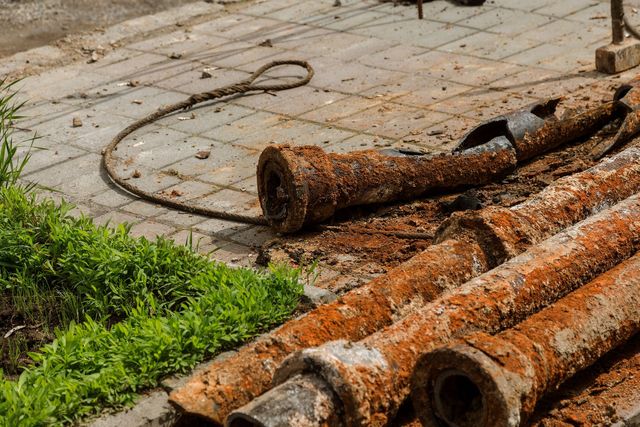Homeowners insurance may cover replacing cast iron pipes, depending on the cause of damage. Cast iron pipe replacement is typically covered by homeowners insurance if the damage is sudden and accidental, such as a burst pipe due to freezing.
However, coverage may vary depending on the policy terms and the specific circumstances of the damage. It’s important for homeowners to review their insurance policy to understand what is and isn’t covered in terms of replacing cast iron pipes. By being aware of their coverage options, homeowners can make informed decisions to protect their property and finances in case of unexpected pipe damage.
Credit: totalcarerestoration.com
Introduction To Homeowners Insurance And Cast Iron Pipes
Homeowners insurance can be a saving grace when unexpected issues arise in your home, such as a burst pipe. However, when it comes to replacing cast iron pipes, homeowners may wonder if their insurance will cover the cost. Understanding the basics of homeowners insurance and the role of cast iron pipes in home plumbing can shed light on what to expect in such situations.
Basics Of Homeowners Insurance
Homeowners insurance provides financial protection against damage to a person’s home and its contents. It typically covers damage caused by fire, wind, hail, lightning, theft, and more. However, coverage for specific items, such as cast iron pipes, can vary based on the policy and the cause of the damage.
Role Of Cast Iron Pipes In Home Plumbing
Cast iron pipes have been a common choice for plumbing systems in older homes due to their durability and longevity. Over time, these pipes can corrode, leading to leaks and other issues. Understanding the role of cast iron pipes in home plumbing can help homeowners anticipate potential problems and determine if their insurance will cover the necessary replacements.

Credit: www.continentalpublicadjusters.com
Typical Coverage Scope Of Homeowners Insurance
The typical coverage scope of homeowners insurance is essential to understand for homeowners who may need to replace cast iron pipes in their homes. Homeowners insurance generally offers coverage for a wide range of perils, providing financial protection for the structure of the home, personal belongings, and liability for injuries or property damage. It’s important to know what homeowners insurance typically covers and the common exclusions to ensure you have the right coverage for replacing cast iron pipes.
What Does Homeowners Insurance Generally Cover?
Homeowners insurance generally covers the following:
- Damage to the structure of the home from covered perils such as fire, windstorm, or vandalism.
- Loss or damage to personal belongings, including furniture, clothing, and electronics.
- Liability for injuries or property damage to others occurring on the property.
- Additional living expenses if the home becomes uninhabitable due to a covered loss.
Common Exclusions In Homeowners Policies
While homeowners insurance offers broad coverage, it’s important to be aware of common exclusions, which may include:
- Damage caused by floods and earthquakes.
- Wear and tear or gradual deterioration of the home or its components, such as cast iron pipes.
- Damage from pests, such as termites or rodents.
- Damage resulting from lack of maintenance or neglect.
Specifics Of Cast Iron Pipes
Homeowners insurance coverage for replacing cast iron pipes varies depending on the policy and the cause of the damage. It is important to review your policy carefully and speak with your insurance provider to determine what is covered and what is not.
Additionally, regular maintenance and inspection can help prevent costly damage to your pipes.
Characteristics Of Cast Iron Pipes
Common Issues With Cast Iron Plumbing
Specifics of Cast Iron Pipes: Cast iron pipes are durable and long-lasting plumbing materials commonly found in older homes. They are known for their strength and ability to withstand heavy loads.
Characteristics of Cast Iron Pipes: These pipes are characterized by their thick walls and heavy weight, making them resistant to damage and ideal for underground installations.
Common Issues with Cast Iron Plumbing: Over time, cast iron pipes can deteriorate due to corrosion, leading to issues such as leaks, blockages, and potential structural damage.
Leakage: Corrosion in cast iron pipes can result in leaks, causing water damage and mold growth.
Blockages: Build-up of debris and mineral deposits inside the pipes can lead to blockages, affecting water flow and drainage.
Structural Damage: As cast iron pipes age, they may develop cracks or fractures, compromising the integrity of the plumbing system.
Assessing Insurance Needs For Older Homes
Importance Of Updated Plumbing
Older homes often come with unique charm and character, but they can also bring along a set of challenges, especially when it comes to plumbing. Having updated plumbing is crucial for the overall integrity of an older home. Cast iron pipes, commonly used in older homes, may deteriorate over time, leading to potential issues like corrosion, leaks, and blockages. This emphasizes the significance of having updated plumbing to ensure the efficient functioning of the home’s water and waste disposal systems.
Evaluating The Condition Of Existing Pipes
Before delving into the coverage aspect, it’s essential to assess the condition of the existing pipes in an older home. Consider engaging a professional plumber to conduct a thorough inspection. This evaluation can reveal any signs of deterioration, corrosion, or potential problems that might necessitate pipe replacement. Understanding the current state of the pipes is pivotal in determining the adequacy of insurance coverage for potential repairs or replacements.
Claims And Coverage For Pipe Replacement
Homeowners insurance can be a savior when unexpected pipe issues arise, but understanding the coverage and claim process is crucial. Let’s explore the specifics of when insurers cover pipe replacement and delve into real-life case studies of successful claims and denials.
When Do Insurers Cover Pipe Replacement?
Insurers typically cover the replacement of cast iron pipes if the damage is sudden and accidental, such as a burst pipe due to freezing temperatures. However, coverage may vary based on the specific policy and the cause of the pipe damage.
Case Studies: Claims Success And Denial
Success: John’s insurer approved the full replacement of his cast iron pipes after a sudden pipe burst caused water damage to his home. The claim process was smooth, and he received the necessary financial support.
Denial: Sarah’s claim for pipe replacement was denied as the damage was deemed to be a result of long-term corrosion rather than a sudden and accidental incident. This case highlights the importance of understanding policy terms and exclusions.
How To File A Claim For Pipe Replacement
To file a claim for pipe replacement, verify if your homeowners insurance covers cast iron pipes. Contact your provider for details on the claim process and ensure all necessary documentation is submitted for approval. Familiarize yourself with any policy limitations or exclusions that may affect coverage.
Steps To File A Claim
Here are the steps to file a claim for replacing cast iron pipes under your homeowners insurance:
- Review your policy details to confirm coverage for pipe replacement.
- Contact your insurance company to start the claims process.
- Schedule an inspection for the damaged cast iron pipes.
- Get a professional assessment and estimate for the replacement.
- Submit all required documentation to support your claim.
- Wait for approval and confirmation from your insurance provider.
- Once approved, work with the insurer to replace the cast iron pipes.
Documentation And Assessment Requirements
When filing a claim for cast iron pipe replacement, you need to gather the following documentation:
- Policy details showing coverage for pipe damage.
- Proof of the pipe’s damage and need for replacement.
- Professional assessment report and cost estimate.
- Photos or videos of the damaged cast iron pipes.
- Any communication with the insurance company regarding the claim.
Preventive Measures And Maintenance
When it comes to homeowners insurance coverage for replacing cast iron pipes, it’s essential to understand the preventive measures and maintenance that can help minimize the risk of potential damage. By taking proactive steps to care for your cast iron pipes, you can potentially avoid costly repairs and ensure that your insurance coverage adequately protects your property.
Regular Maintenance Tips For Cast Iron Pipes
Regular maintenance is crucial for prolonging the lifespan of cast iron pipes and preventing issues that may not be covered by homeowners insurance. Here are some simple yet effective maintenance tips to keep your pipes in good condition:
- Schedule regular inspections by a professional to check for signs of corrosion, cracks, or blockages.
- Clear debris and buildup to prevent clogs and maintain proper water flow.
- Avoid flushing non-biodegradable items such as wipes, paper towels, and feminine hygiene products.
- Monitor tree roots that may intrude on underground pipes and cause damage over time.
Preventive Upgrades To Consider
In addition to regular maintenance, homeowners can consider implementing preventive upgrades to further safeguard their cast iron pipes against potential damage. These upgrades may not only enhance the durability of the pipes but also contribute to a more comprehensive insurance coverage. Here are some preventive upgrades to consider:
- Epoxy pipe lining to create a protective barrier inside the pipes and prevent corrosion.
- Installation of backwater valves to prevent sewage backups and water damage during heavy rainfall.
- Upgrading to PVC piping in areas prone to frequent pipe issues for a more durable and long-lasting solution.

Credit: www.moneygeek.com
Navigating Insurance Upgrades And Policy Reviews
When it’s time to navigate insurance upgrades and policy reviews, understanding the scope of coverage for replacing cast iron pipes under homeowners insurance is crucial. Navigating insurance upgrades and policy reviews can help ensure that your home is adequately protected against potential plumbing issues.
When To Review And Update Your Insurance Policy
It’s essential to review and update your insurance policy when major home upgrades or renovations are planned. Additionally, consider policy updates when your home’s plumbing system is aging, as this can impact coverage for replacing cast iron pipes.
Choosing The Right Coverage For Plumbing Needs
When selecting homeowners insurance, prioritize policies that explicitly cover the replacement of cast iron pipes. Ensure that the policy provides coverage for potential damage caused by pipe deterioration and subsequent repairs.
Frequently Asked Questions
Does Homeowners Insurance Cover Repiping?
Homeowners insurance typically doesn’t cover repiping unless it’s due to a sudden event like a burst pipe.
How Much Does It Cost To Replace A Cast Iron Plumbing Stack?
The cost to replace a cast iron plumbing stack typically ranges from $1,500 to $4,000, depending on various factors.
Should You Replace Cast Iron Plumbing?
Yes, consider replacing cast iron plumbing if it’s old, corroded, or causing frequent clogs and leaks.
Does Homeowners Insurance Cover Broken Pipes Under Foundation?
Yes, homeowners insurance typically covers damage from broken pipes under the foundation if it’s sudden and accidental. However, it’s important to check your policy’s specific coverage and exclusions. It’s also recommended to regularly maintain your plumbing to prevent potential damage.
Conclusion
Homeowners insurance coverage for replacing cast iron pipes can vary. It’s essential to review your policy details and consult with your insurance provider for clarity. Understanding the coverage available can help you make informed decisions about protecting your home and finances.
